| The Disappearance of Storyville |


Storyville, the only legal Red Light district in the country at the time, lasted from
1897 to 1917. It was eventually closed by order of the U. S. Department of the
Navy. By that time, the District's fortunes had already declined and its political
power had started to wane. Within 25 years of its closing, most of the buildings of
Storyville had disappeared.
In 1938, the neighborhood had become very run down. By 1939, less than a year
after it was formed, HANO had purchased and demolished most of what had been
Storyville and erected in its place the Authority's first project, the Iberville
Housing Project.
While some saw no reason to mourn the loss of the sometimes gaudy excesses of
the sporting palaces and the haphazard architecture of the saloons of Storyville,
many will agree that the wholesale destruction of the neighborhood where jazz
was nurtured by some of the legendary pioneers of the day, is certainly to be
regretted.
Much was lost in the decades before citizens realized the danger and formed
preservation associations in New Orleans to stop the demolitions that had
already robbed the city of some of its history. These groups have been very
successful.
But, in the wake of the levee failures in 2005, when so much was lost, it's even
more critical to continue to try to save as much as can possibly be saved.
-- Nancy
1897 to 1917. It was eventually closed by order of the U. S. Department of the
Navy. By that time, the District's fortunes had already declined and its political
power had started to wane. Within 25 years of its closing, most of the buildings of
Storyville had disappeared.
In 1938, the neighborhood had become very run down. By 1939, less than a year
after it was formed, HANO had purchased and demolished most of what had been
Storyville and erected in its place the Authority's first project, the Iberville
Housing Project.
While some saw no reason to mourn the loss of the sometimes gaudy excesses of
the sporting palaces and the haphazard architecture of the saloons of Storyville,
many will agree that the wholesale destruction of the neighborhood where jazz
was nurtured by some of the legendary pioneers of the day, is certainly to be
regretted.
Much was lost in the decades before citizens realized the danger and formed
preservation associations in New Orleans to stop the demolitions that had
already robbed the city of some of its history. These groups have been very
successful.
But, in the wake of the levee failures in 2005, when so much was lost, it's even
more critical to continue to try to save as much as can possibly be saved.
-- Nancy
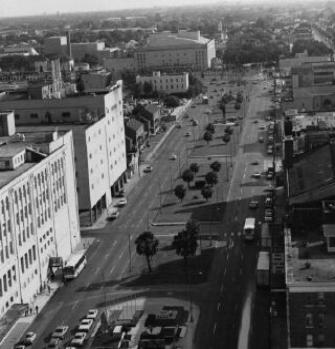
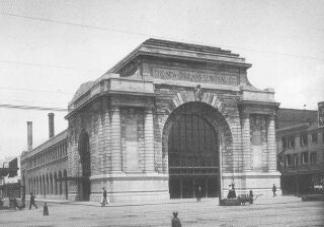
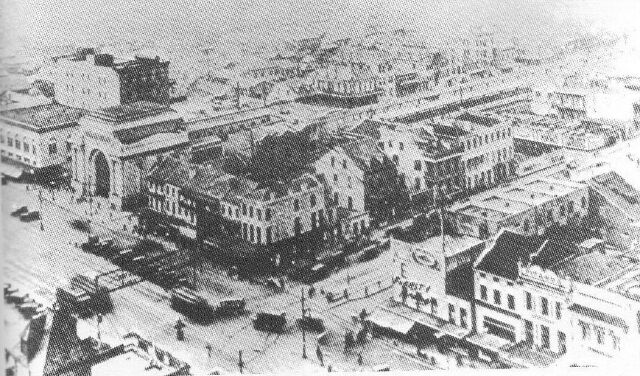
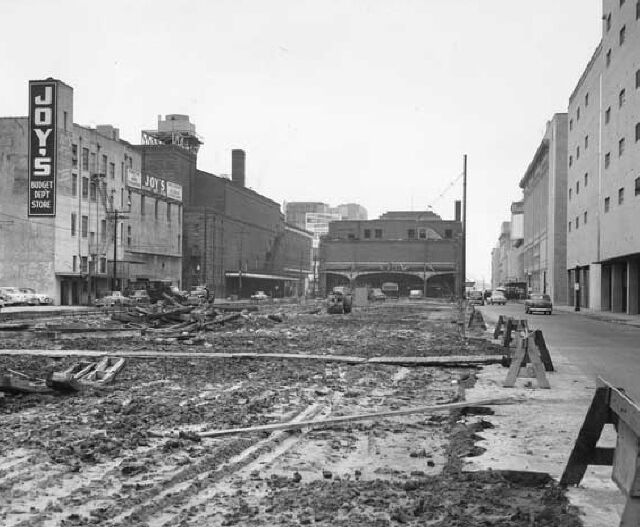
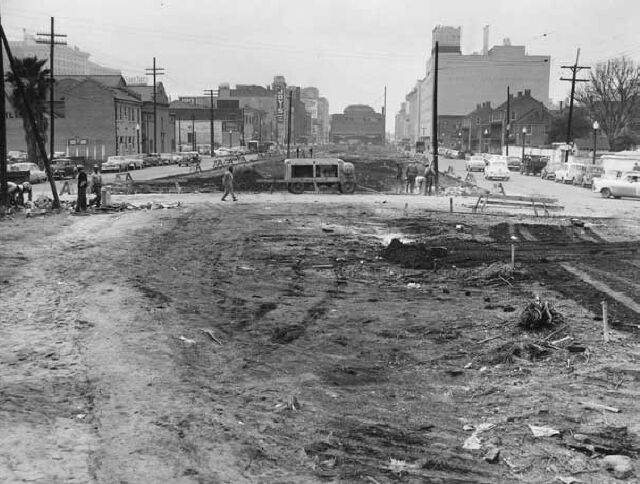
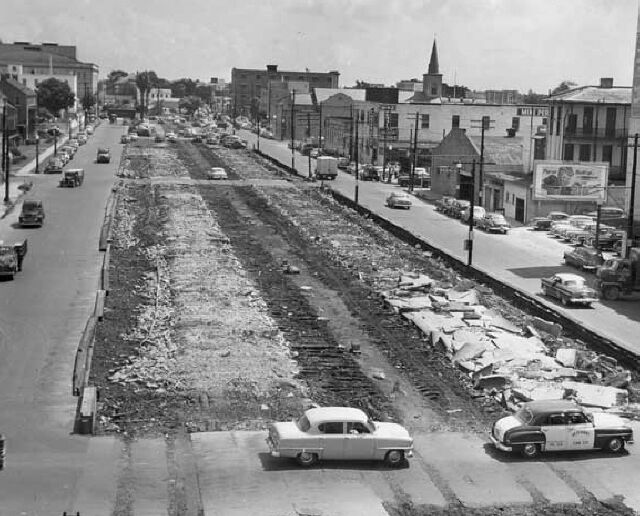
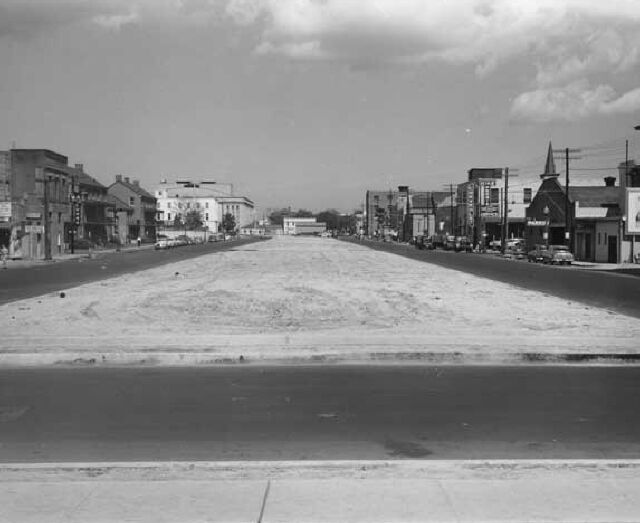
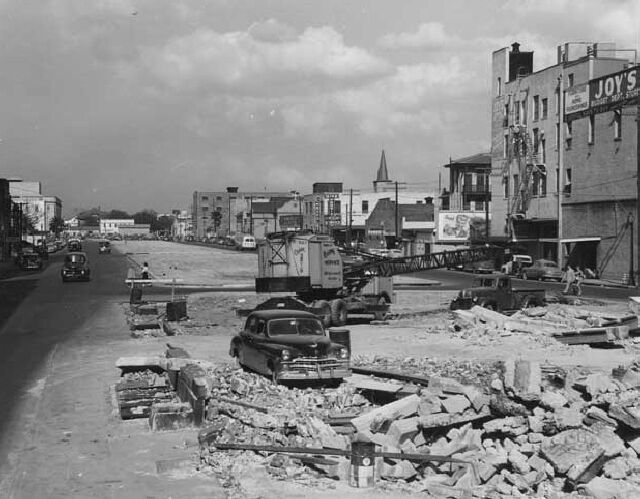
| The wide street in the foreground is Canal Street and the prominent building with the arch, facing Canal is the Southern Railroad Terminal designed by Daniel Burnham and constructed in 1908. It was demolished after the Union Passenger Terminal was built in 1954. The train sheds stretching out behind Southern Terminal parallel Basin Street, one of Storyville's boundaries. You can see Krauss Department store just beyond the train station; Krauss opened in 1903. Some time after Storyville was closed, Krauss purchased virtually the entire 200 block of Basin Street, and constructed warehouses and parking lots on the spots where the mansions of Tom Anderson, Josie Arlington and Lulu White had once stood. |
| Above, the impressive Southern Railroad Terminal. Right, Basin Street after the Terminal and train sheds were gone. The land where the station and train sheds stood was designated as the "Garden of the Americas." Monuments dedicated to 3 Latin American heroes were erected along Basin Street between Canal and the Municipal Auditorium. |
| Basin Street, looking south from St. Louis Street, during demolition of train sheds; Southern Terminal can be seen in the distance on Canal Street; 1954. |
| Same view as above, closer to Canal Street; rear of Southern Terminal can be seen clearly; buildings on the right, part of the Krauss Department Store complex. The Saenger Theatre (left of Terminal, facing Canal) was built in 1925, on a narrow block, which, interestingly, allowed access to it from 4 streets. It was designed by the firm of Emile Weil & Associates. Prior to the building of the theater, this square was filled with three-level townhouses; six faced Canal Street, four faced the side of the Southern Terminal and four faced N. Rampart Street. Mahogany Hall and The Palace, Lulu White and Josie Arlington's sporting palaces, once stood to the right in this photo, where the large Krauss building is now located. |
| Basin Street, looking north from Iberville Street during the train sheds demolition, 1954. The steeple from the Yellow Fever Mortuary Chapel, on N. Rampart Street, can be seen in the distance. |
| Basin, looking north from Iberville after some of the work on the neutral ground had been completed. This is a wider view and a couple of the Iberville Housing Project buildings, which replaced most of Storyville, can be seen on the left. The Municipal Auditorium, or part of it, can be spotted in the distance, to the left. |
| Same as photo above, different angle. |
| Back to Page 1: Storyville & the Birth of Jazz Back to New Orleans & the Birth of Jazz Old New Orleans Index Whispers - Home |
...
| When the night falls on Storyville, if the women don't get ya, the music will. -- J. R. Robertson, from the album, "Storyville" |
